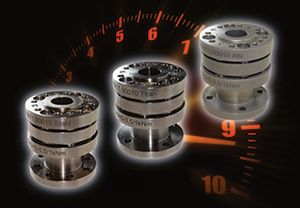
Posted to News on 22nd Apr 2021, 00:00
Reliable protection for high speed applications
The experts at Mayr Power Transmission offer their advice on selecting the right torque limiters and shaft couplings for high speed applications.

Drive axes in the high-speed range require reliable clutches and couplings, because if collisions occur at high speeds, they can cause severe damage. But couplings do not only provide overload protection. Dynamic and high-precision shaft misalignment compensation couplings also create the prerequisites for exact measurement results, especially in test stand technology.
In most industries, an increasing demand for dynamic, fast-rotating drive axes well beyond the classic 1,500 rpm can be observed. And in particular in the measurement and test stand technology, the solutions must also be highly precise. Furthermore, at the high speeds, the safety and reliability of the drive line is a particular concern, with collisions potentially resulting in serious injuries or damage materials.
For this purpose, mechanical torque limiting clutches are used to protect the test pieces and measuring units. These open the drive line and decouple the running masses within fractions of a second – faster than electronic monitoring functions. When selecting the right clutch, however, it is important to consider a number of points. After all, an imprecise or slow clutch which influences the measurement system or triggers at the wrong time not only makes evaluation in the test field difficult, but also simply defeats its purpose.
High performance density
The torque limiter, which protects test pieces and measuring units from damage due to overload, must fit high-precision systems and must be suitable for high-speed in terms of its basis. In addition, it is important that the clutches transmit the torque backlash-free and with high torsional rigidity. “Our EAS-HSE high-speed element clutches are compact, have a high performance density and a low mass moment of inertia,” explains Ralf Epple, product manager at Mayr Power Transmission.
“With our latest addition to the series, we are responding to the requirements of the market and offer users new, weight-optimised solutions even in the standard range. For special applications, we are also able to go one step further and reduce the weights even more.”
The compact, high-performance design of the clutches is achieved through a small outer diameter with a relatively large bore diameter. Further, the integrated elements, via which the torque is transmitted on the EAS-HSE clutch, are specially selected and symmetrically arranged, delivering a low-vibration system that works precisely in the event of actuation.
With the addition to the series, Mayr is now offering torque limiters for high-speed applications with torques in the standard range from 30 Nm to 15,000 Nm and speeds of 25,000 rpm for small and 8,000 rpm for large construction sizes. “We have noticed a kind of speed maximum at 25,000 rpm to 30,000 rpm for industrial test stands,” Epple adds. “However, in the area of research and development, where we cooperate with universities and other research institutes, or in motor sports, there are projects with speeds well above 30,000 rpm. We use the experiences gained from these projects to further develop our standard range.”
He continues: “We have been closely observing the market developments for a long time in order to be prepared for the high speeds. This includes our high-speed element clutches as well as our overload clutches.” The company has therefore developed a new standard series for the established EAS-Compact-F overload clutch up to 12,000 rpm, which takes into account the consistently increasing requirements in terms of speed and dynamics. In the new series, for example, an internal seal ensures reliable lubrication of the functional components. This in turn ensures reliable disengagement even under extreme conditions and at high speeds.
Shaft misalignment compensation
In addition to torque limiters, shaft misalignment compensation couplings are a key accessory in test stands, as they minimise the interference parameters affecting the measurement flange. Such interference parameters or so-called parasitic forces frequently occur due to alignment errors in the drive line. For this reason, misalignments between the input and the output sides occur in almost all applications.
Shaft misalignment compensation couplings are therefore used together with the measurement flange. Based on the tried and tested backlash-free and torsionally rigid ROBA-DS construc-tion series, Mayr offers a version of its compensation coupling specially adapted to measurement flanges, which creates ideal prerequisites for accurate measurement results.
These disk pack couplings reliably handle the high speeds and even the standard version made of steel is compact, has low mass and inertia, and achieves speeds of up to 30,000 rpm. In addition, these couplings stand out due to precise manufacturing with very few interfaces, high running smoothness and balance quality. “It is our ultimate goal to produce couplings that are compact and of high performance density,” emphasizes Ralf Epple.
“The geometric basis must be right. There is no point in simply designing a large coupling in aluminum or titanium, when a compact steel version, which is more rigid and can handle more alternating loads, may be better suited to the application.”
That’s why customers should always consider the application when selecting the coupling and the material. Here, however, it is always necessary to weigh up between the material properties, including weight, rigidity or fatigue strength, and the final customer application, ie the actual speeds, load alterations, load cycles, bearing distances and bore diameters. And last but not least, of course, the price/performance ratio also counts.
Comparing steel, aluminum and titanium
In the area of measurement technology, torsional rigidity is often an important decision criterion, especially when test stands have the task of measuring the likes of torsion angles or elasticities. Not even titanium can match the rigidity of steel here. However, if the focus is on many acceleration cycles and the mass moment of inertia, then lightweight versions made of aluminum or titanium may be the better choice.
Titanium is particularly suitable for endurance tests and when many load alternations occur. And also in this area, developments continue apace.
“We are working with leading manufacturers of measuring flanges in this field,” says Epple. “In future, direct connection to new high-speed measurement flanges will be possible, and here, too, there will be versions in various materials.”
10/11 Valley Road Business Park
Valley Road
BD21 4LZ
UNITED KINGDOM
+44 (0)1535 663900








